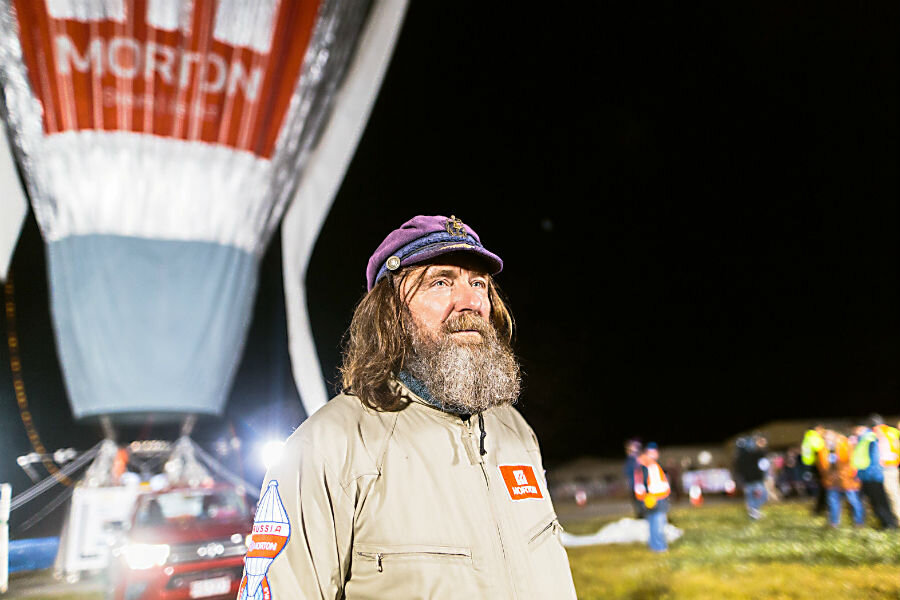Russian sets new balloon record: Around the world in 11 days
Loading...
| Canberra, Australia
A cold and exhausted 65-year-old Russian balloonist came back to Earth with a bruising thud in the Australian Outback on Saturday after claiming a new world record by flying solo around the world nonstop in 11 days, officials said.
Fedor Konyukhov landed 160 kilometers (100 miles) east of Northam, where he started his journey on July 12, about three hours after he flew over the same town on his return, flight coordinator John Wallington said.
"He's landed, he's safe, he's sound, he's happy," Wallington said from the landing site. "It's just amazing."
"It's fantastic — the record's broken, everyone's safe. It's all good," he added.
Konyukhov's gondola — a carbon box 2 meters (6 feet, 7 inches) high, 2 meters long and 1.8 meters (5 feet, 11 inches) wide — bounced twice over 200 meters (yards) in an empty field and tipped on its side before the support crew grabbed it to prevent the deflating balloon from dragging it farther, crew member Steve Griffin said.
"He's got a bruise on his cheek, but he's pretty well unscathed," Griffin said.
Video of the landing showed Konyukhov smiling but silent as he emerged from the gondola. He stroked his bearded left cheek and wiped his eyes as he was hugged and cheered by supporters.
Konyukhov flew by helicopter back to Northam, where his first shower in 11 days was a priority, Griffin said.
Konyukhov demonstrated precision navigation of his 56-meter (184-foot) -tall helium and hot-airballoon by returning to Australia directly over the west coast city of Perth, then over the airfield at Northam, 96 kilometers (60 miles) to the east by road.
American businessman Steve Fossett also started from Northam to set a record of 13 days, 8 hours for his 33,000-kilometer (20,500-mile) journey in 2002.
Konyukhov, a Russian Orthodox priest, took a longer route and roughly 11 days, 6 hours to complete the circumnavigation.
Crews in six helicopters followed the 1.6-metric-ton (1.8-ton) balloon from Northam inland to help him land.
His journey of more than 34,000 kilometers (21,100 miles) took him through a thunder storm in the Antarctic Circle, where temperatures outside the gondola fell to minus-50 degrees Celsius (minus-58 Fahrenheit).
The gondola heating stopped working on Thursday, so Konyukhov had to thaw his drinking water with the balloon's main hot air burner, Wallington said.
The journey also took him to speeds up to 240 kilometers (150 miles) per hour and heights up to 10,614 meters (34,823 feet) before he released helium to prevent the balloon from continually climbing as its fuel load lightened, Konyukhov's son Oscar said.
Konyukhov aimed to get four hours of sleep a day in naps of 30 or 40 minutes between hours of checking and maintaining equipment and instruments.
He used a bucket for a toilet and emptied it over the side.
Konyukhov's team had said that landing the balloon could be the most challenging and dangerous part of the journey.
Fossett, who was 58 at the time, was forced by strong winds to spend more than a day in the air after setting his own record as the first person to circle the globe in a balloon. His capsule tumbled along the ground for 15 minutes after he landed on a cattle ranch in southwest Australia's Queensland state. He emerged from the capsule with a bloodied mouth from biting his lip during the rough landing, but was otherwise unhurt.
The Swiss-based World Air Sports Federation did not immediately respond to a request for confirmation of the new record.
The Australian Broadcasting Corporation reported that Australian adventure rDick Smith said Mr Konyukhov was in "incredibly good condition" after his flight.
"The landing was exciting — the balloon got dragged along and the gondola got bashed around, and when it stopped, Fedor didn't get straight out. I thought he was knocked out. But he was just waiting for it to be calm," he said.
"It's a very risky undertaking — the fact that he came right back across the northern airfields where he took off from — no one has ever done that. It's so incredibly rare, that it's about a one in a billion chance.
"There are so many wind currents and direction changes around the world. Steve Fossett took off in northern and ended up in Birdsville and everyone thought that was impressive."







